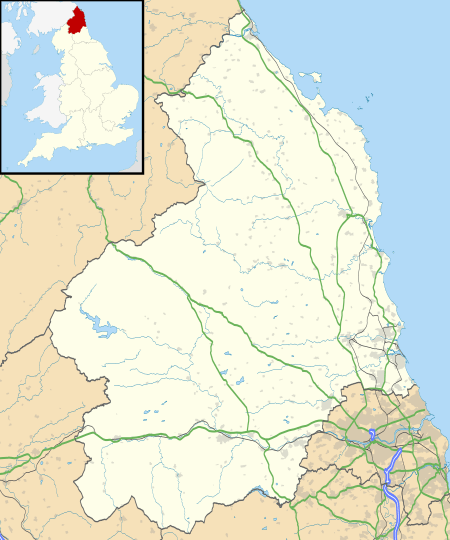Otterburn, Northumberland
Otterburn is a small village in Northumberland, England, 31 miles (50 km) northwest of Newcastle upon Tyne on the banks of the River Rede, near the confluence of the Otter Burn, from which the village derives its name. It lies within the Cheviot Hills about 16 miles (26 km) from the Scottish border. The parish of Otterburn is at the heart of Redesdale, a Northumbrian upland valley.
| Otterburn | |
|---|---|
 Otterburn | |
 Otterburn Location within Northumberland | |
| Population | 654 (2011)[1] |
| OS grid reference | NY885935 |
| Unitary authority | |
| Ceremonial county | |
| Region | |
| Country | England |
| Sovereign state | United Kingdom |
| Post town | NEWCASTLE UPON TYNE |
| Postcode district | NE19 |
| Dialling code | 01830 |
| Police | Northumbria |
| Fire | Northumberland |
| Ambulance | North East |
| UK Parliament | |
History
The name simply means otter stream, a stream frequented by otters (Old English otor + brunna). Otterburn was the site of a major battle in 1388 between English and Scottish armies. The engagement, in which the Scots took Sir Henry Percy captive, is the subject of the English Ballad of Chevy Chase and the Scots ballad Otterburn.
The battle of Otterburn ended in an English rout. Despite James Douglas, 2nd Earl of Douglas being killed, Percy was captured and over a thousand of the English were taken, left dead on the field or slain as they fled. The dead were carried to Elsdon church, 3 miles (4.8 km) from Otterburn, where they were buried.
The modern village grew up around a coaching inn and Otterburn Tower. It was enlarged in the 1950s with the addition of Brierley Gardens, a council estate which was expanded in the 1970s. The village further expanded in the 1990s and 2000s with the new housing development on former farm land at Willow Green.
Governance
Otterburn is in the parliamentary constituency of Hexham, Guy Opperman of the Conservative Party is the Member of Parliament.
Prior to Brexit, for the European Parliament its residents voted to elect MEP's for the North East England constituency.
For Local Government purposes it belongs to Northumberland County Council a unitary authority.
Economy
Today, the village is close to the Otterburn Training Area, one of the UK's largest army training ranges at approximately 60,000 acres (240 km2). The village also has an independent general grocery shop, two hotels and Otterburn Mill, an 18th-century woollen mill containing a small museum, outdoor shop and cafe.
Landmarks
- Otterburn Hall, now a hotel, is a Neo-Elizabethan structure, built in 1870 for Lord James Douglas, and which is now currently shut.
- St John the Evangelist's Church, Otterburn
- Otterburn Mill is now a retail outlet and cafe.
- Otterburn Tower, changed name to Otterburn Castle, now a hotel, was built in 1830 incorporating part of an eighteenth-century house, which itself may have incorporated the thirteenth-century tower house which originally stood on the site.[2]
- The "Percy Cross" stands within a small plantation, half a mile north of the village. Near this spot, on an August evening in 1388, an English army of 8,000 men followed Sir Henry Percy into battle against the Scots, led by James Douglas, 2nd Earl of Douglas.
References
- "Parish population 2011". Retrieved 25 June 2015.
- Otterburn Tower
External links
| Wikimedia Commons has media related to Otterburn. |